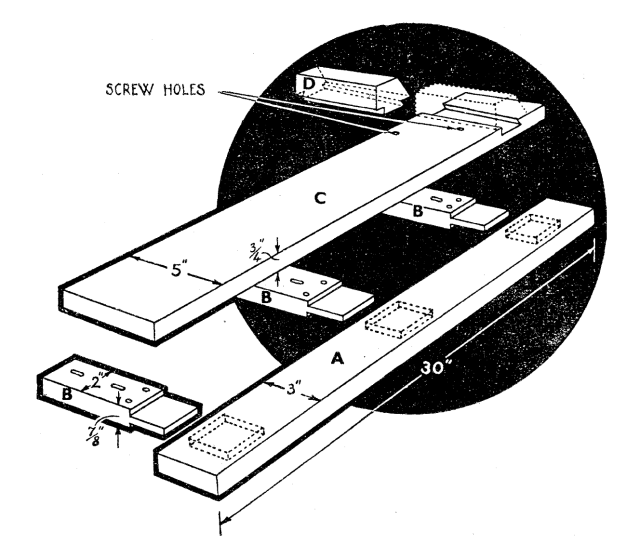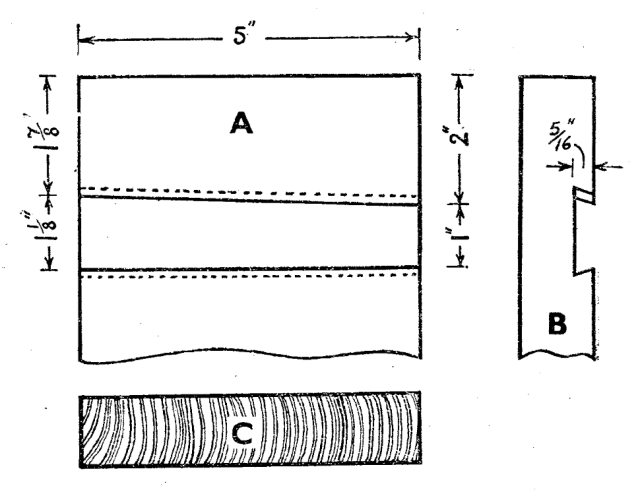
If well made this board should give many years of reliable use
The following is excerpted from the fourth book in our series “The Woodworker: The Charles H. Hayward Years,” which covers three different topics.
1) The Workshop, including the design and construction of workbenches, tool chests and wall cabinets. There’s also an entire section devoted to “appliances,”which are workshop accessories such as shooting boards.
2) Furniture & its Details, includes a discussion of all the important Western furniture styles, including their construction, mouldings and metal hardware. This section also includes the construction drawings for many important and famous pieces of furniture examined by Charles H. Hayward during his tenure at The Woodworker magazine (1939 to 1967).
3) Odds & Sods. In addition to offering its readers practical information for the shop, The Woodworker also asked it subscribers to think about the craft and its place in modern society. We have included many of our favorite philosophical pieces in this final section.
This combined shooting board, mitre shoot, and “donkey’s ear” can be a real asset to the craftsman. It will last a lifetime and prove invaluable in the construction of small photograph frames, and for bench work generally. Skill in its various uses quickly comes with practice, and the parts are easily interchanged.
Many home craftsmen do not bother about the shooting board, but no man who has experienced its use would be without one. This design of board serves several purposes. It is as well to make it of prime timber. Rift sawn stuff is the best, as it resists abrasion better, and tends to stay flatter. Possibly a couple of short ends may be procured from firms specialising in flooring timbers. Note how the annual rings run in rift sawn timber (Fig. 5, C). Fig. 1 is an exploded drawing of the shooting board, giving main sizes. The length may be increased if desired.
The 3-in. wide board (A) takes the bearing of the plane. Its top surface must be planed absolutely true and checked with winding strips. Three bearing pieces are tenoned into the board (A), and it is as well to run the mortises right through the board. Fit the bearers (B) and glue and cramp them home, securing by wedges from the front edge if the mortises have been taken right through (A). When the framework is dry, plane it flat and check its truth again with winding strips.

If board (C) is planed true and even in thickness, its top surface should form a plane parallel with that of board (A) when it is fastened to the runners. To secure board (C) in place insert screws through holes and slots in the bearers as shown in Fig. 1. It is inadvisable to make a shooting board by simply attaching a narrow board to a wide one, since air is excluded from the contacting surfaces and twisting or warping may result.
Furthermore the three bearers (B) act as clamps to board (C) holding it flat.
Stop. The slot for the stop D is a diminished dovetailed housing, details of which are given in Fig. 5 (A), and (B). The stop itself is made longer than the width of the board, fitted, and tapped tightly home. The end that overhangs board (A) is then cut so that the stop fits flush with the edge of board (C). Do not be satisfied until a good fit is obtained. Check the squareness of the stop with the edge of board (C). This may be done with the try-square if you know your square to be accurate, but woodworkers’ squares are notoriously “near enough” and if in doubt a celluloid set-square can be used. Now fit a batten to the underside of the three bearers in order that the shooting board may be held in a vice. This is shown in Fig. 2.

Mitre Shoot. So much for the plain shooting board; the adapting block for the mitre shoot is shown in Fig. 3. This should also be checked with a 45° set square as shown. The block is screwed to board (C ) from underneath, and should be tight against the stop.
Donkey’s Ear. Fig. 4 shows the adaptation for the donkey’s ear. This consists of a built-up block (A) with a piece (B) screwed to its end to act as a stop. 1-in. timber is suitable for the block, the pieces being glued and screwed together. The width of the timber need be only 4 or 5 in. It is as well to make the block longer than required, and saw it to size and shape. The bottom face is most difficult to true, and should be planed first and checked for truth with winding strips. Next plane the far end square and vertical to the base, and true the slant-face last. The piece (B) is screwed to the end of the block and, by fitting against the main stop of the shooting board, is reinforced to take the thrust of the plane. Screws fasten the block to the board as before.
The donkey’s ear must be true in two directions. The 45° angle may be checked with the set square against the sole of the plane. The 90° angle, i.e. the angle between the stop and the sole of the plane, can also be checked with the set square.
/*<![CDATA[*/
(function () {
var scriptURL = 'https://sdks.shopifycdn.com/buy-button/latest/buy-button-storefront.min.js';
if (window.ShopifyBuy) {
if (window.ShopifyBuy.UI) {
ShopifyBuyInit();
} else {
loadScript();
}
} else {
loadScript();
}
function loadScript() {
var script = document.createElement('script');
script.async = true;
script.src = scriptURL;
(document.getElementsByTagName('head')[0] || document.getElementsByTagName('body')[0]).appendChild(script);
script.onload = ShopifyBuyInit;
}
function ShopifyBuyInit() {
var client = ShopifyBuy.buildClient({
domain: 'lost-art-press-test.myshopify.com',
storefrontAccessToken: 'f83226aac752f3a8e262f8a8273c9739',
});
ShopifyBuy.UI.onReady(client).then(function (ui) {
ui.createComponent('collection', {
id: '166162563135',
node: document.getElementById('collection-component-1692812224046'),
moneyFormat: '%24%7B%7Bamount%7D%7D',
options: {
"product": {
"styles": {
"product": {
"@media (min-width: 601px)": {
"max-width": "calc(25% – 20px)",
"margin-left": "20px",
"margin-bottom": "50px",
"width": "calc(25% – 20px)"
},
"img": {
"height": "calc(100% – 15px)",
"position": "absolute",
"left": "0",
"right": "0",
"top": "0"
},
"imgWrapper": {
"padding-top": "calc(75% + 15px)",
"position": "relative",
"height": "0"
}
},
"title": {
"font-size": "16px"
},
"button": {
"font-size": "14px",
"padding-top": "15px",
"padding-bottom": "15px",
"border-radius": "11px"
},
"quantityInput": {
"font-size": "14px",
"padding-top": "15px",
"padding-bottom": "15px"
}
},
"text": {
"button": "Add to cart"
}
},
"productSet": {
"styles": {
"products": {
"@media (min-width: 601px)": {
"margin-left": "-20px"
}
}
}
},
"modalProduct": {
"contents": {
"img": false,
"imgWithCarousel": true,
"button": false,
"buttonWithQuantity": true
},
"styles": {
"product": {
"@media (min-width: 601px)": {
"max-width": "100%",
"margin-left": "0px",
"margin-bottom": "0px"
}
},
"button": {
"font-size": "14px",
"padding-top": "15px",
"padding-bottom": "15px",
"border-radius": "11px"
},
"quantityInput": {
"font-size": "14px",
"padding-top": "15px",
"padding-bottom": "15px"
},
"title": {
"font-family": "Helvetica Neue, sans-serif",
"font-weight": "bold",
"font-size": "26px",
"color": "#4c4c4c"
}
},
"text": {
"button": "Add to cart"
}
},
"option": {},
"cart": {
"styles": {
"button": {
"font-size": "14px",
"padding-top": "15px",
"padding-bottom": "15px",
"border-radius": "11px"
}
},
"text": {
"total": "Subtotal",
"button": "Checkout"
}
},
"toggle": {
"styles": {
"count": {
"font-size": "14px"
}
}
}
},
});
});
}
})();
/*]]>*/